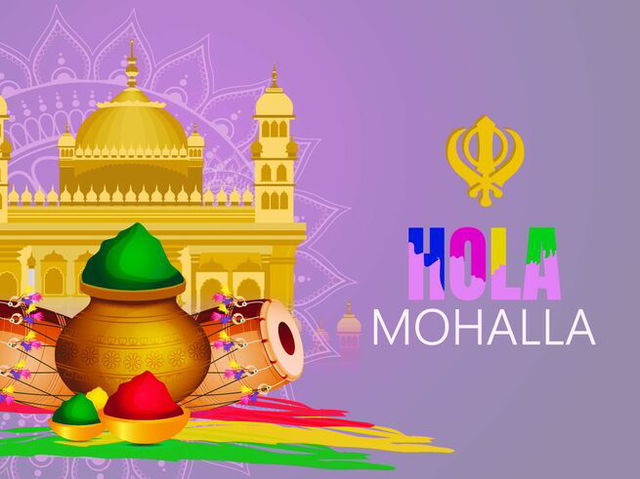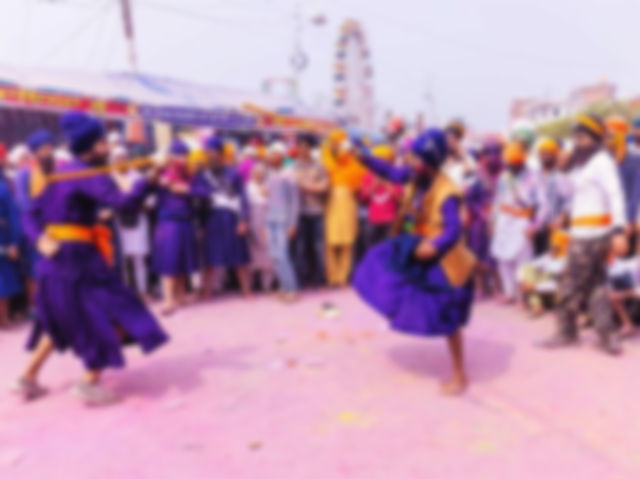Hola Mohalla also known as Hola is an important Sikh festival that falls on the second day of the lunar month of Chett in the Sikh calendar.
It typically falls in the Gregorian month of March that follows or coincides with the Hindu festival of Holi.
Hola Mohalla is a rich historical and cultural tradition that brings together the Sikh community across the globe to honor their heritage with showcase of martial arts, music, poetry, and community gatherings.
The most vibrant celebrations occur at Anandpur Sahib in Punjab, India, where Sikhs from across the globe come together to engage in a distinctive mix of spiritual rituals and displays of strength and solidarity.

Hola Mohalla Meaning
Hola Mohalla, an important Sikh festival, takes its name from Hola, a Sanskrit word rooted in Halla, meaning a military charge. Combined with Mohalla, which denotes an organized procession or army column, the term Hola Mohalla symbolizes “a military charge” or a disciplined march.
Dr. M.S. Ahluwalia explains that the related Punjabi word Mahalia, derived from Hal (to descend or alight), refers to a structured procession resembling an army formation. These processions often feature war drums, standard-bearers, and a coordinated movement towards a specific destination.
While similar in name, Hola is distinct from Holi, the Hindu festival of colors, which is celebrated the day before Hola Mohalla.
History of Hola Mohalla
Hola Mohalla is built upon the spring festival of Holi. Holi is mentioned as a time to celebrate by serving and remembering God in the Sikh holy book which is the Guru Granth Sahib.
The colors of Holi are said to be the symbolism of love and respect for divinity. Holi starts with Holika Dahan on the full moon night of the month of Phagan or Phalguna, but the main day of Holi is celebrated on the first day of the next lunar month, Chett.
Guru Gobind Singh who is the tenth Sikh Guru gave the festival a new meaning by adding a martial element, thus developing it into Hola Mohalla which is celebrated either on or after Holi.
This new festival emphasized strength, unity, and readiness to defend righteousness.
Hola Mohalla is also connected to the story of Prahlada who is a devotee of God refused to worship his father, King Hiranyakashipu, as a deity.
According to the legend, Hiranyakashipu's sister, Holika tried to burn Prahlada alive to please her brother.
She sat with Prahlada in a fire, believing her magical cloth would protect her. However, the cloth shielded Prahlada instead, and Holika was consumed by the flames. This event symbolizes the triumph of good over evil.
Sikh tradition also links to this story. Early Sikhs admired the tale of Prahlada, and the Guru Granth Sahib includes verses about him by saints such as Namdev, Kabir, and the third Guru, Amar Das.
Hola Mohalla thus blends together spiritual devotion, the vibrant colors of Holi, and the Sikh values of bravery and justice, creating a festival that celebrates both faith and courage.
Customs And Practices of Hola Mohalla
According to Thompson in 2000, Guru Gobind Singh started the tradition of Hola Mohalla in the spring of 1701.
Furthermore, in 1994 Cole mentioned that Guru Gobind Singh called his followers to Anandpur on Holi in 1680 and introduced a gathering where they could practice combat skills and maneuvers.
But, the first procession with drums was organized by Guru Gobind Singh in Anandpur on 22 February 1701.
This tradition of mock battles and poetry contests at Lohgarh Fort spread from Anandpur Sahib to Kiratpur Sahib, the foothills of the Shivaliks, and other Gurdwaras worldwide.
Singh (2018) notes that during Hola Mohalla celebrations, swords are highly valued in Nanded because every participant in the procession carries one.

Colors and Celebrations
Bhai Nand Lal, Guru Gobind Singh's court poet, described how participants used colors like rose water, amber, musk, and saffron-colored water after the mock battles.
Sikh tradition says Guru Gobind Singh himself joined in the colorful festivities, using gulal (a red powder), a practice still followed today by Nihangs, who splash gulal on each other and the audience. However, an alternative view suggests that Guru Gobind Singh did not take part in throwing colors.
The Role of Anandpur Sahib
Hola Mohalla is incomplete without mentioning Anandpur Sahib which holds immense historical and spiritual significance for the Sikhs.
Guru Gobind Singh founded the Khalsa here in 1699 which is an order of saint-soldiers committed to protect the faith and standing up against injustice.
Anandpur Sahib is also the site where the first Hola Mohalla celebrations were held, and it remains the focal point of the festival today.
The festival takes place in the open fields near Lohgarh Fort, where Sikhs from all walks of life gather to celebrate and participate in the festivities.
The community comes together in a spirit of unity, sharing meals and participating in the activities that reflect the martial ethos and values of Sikhism.
Nihang Singhs
The Nihang (also spelled Nihung, meaning "Crocodiles") or Akali (meaning "Immortals") is a group of Sikh warriors from the Indian subcontinent. They are also called Dal Khalsa. Their origins are linked either to Fateh Singh and his style of dress or to the "Akal Sena" (meaning "Army of the Immortal") formed by Guru Hargobind. In early Sikh history, the Nihangs were key military figures, known for their bravery and success in battles, even when outnumbered. They were fearless and fierce fighters, often serving as guerrilla units in the Sikh Khalsa Army during the Sikh Empire.
Read Next